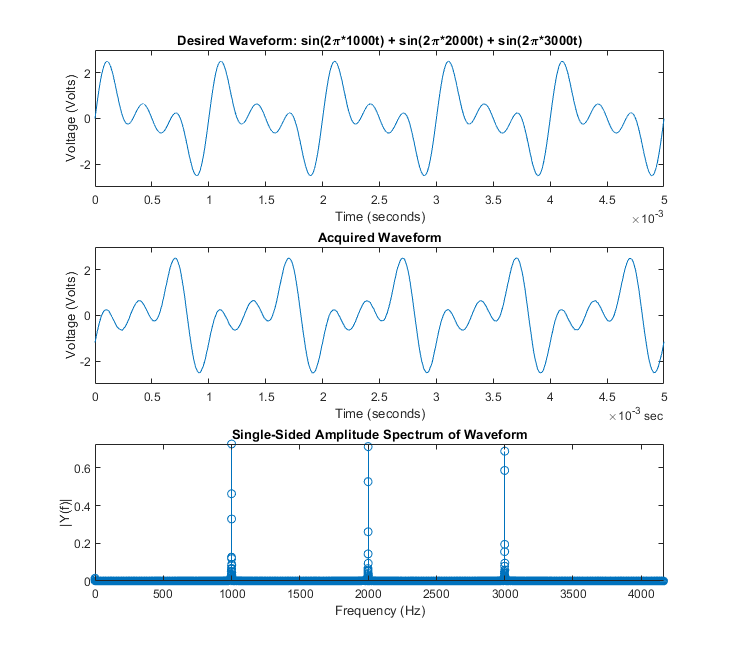Generate Arbitrary Periodic Waveforms Using Digilent Analog Discovery
Use function generator channels to generate an arbitrary 1kHz waveform function, and record data at the same time, using an analog input channel.
Discover Digilent Devices
Discover Digilent devices connected to your system using daqlist.
daqlist("digilent") dq = daq("digilent")
ans =
1×4 table
DeviceID Description Model DeviceInfo
________ _____________________________________________ ____________________ _______________________
"AD1" "Digilent Inc. Analog Discovery 2 Kit Rev. C" "Analog Discovery 2" [1×1 daq.di.DeviceInfo]
dq =
DataAcquisition using Digilent Inc. hardware:
Running: 0
Rate: 10000
NumScansAvailable: 0
NumScansAcquired: 0
NumScansQueued: 0
NumScansOutputByHardware: 0
RateLimit: []
Show channels
Show properties and methods
Add a Function Generator Channel
Add a function generator channel with device ID AD1 and channel ID 1. Set the waveform type to Arbitrary. The voltage range of the output signal is -5.0 to +5.0 volts.
ch_fgen = addoutput(dq, "AD1", "1", "Arbitrary"); ch_fgen.Name = "AD1_1_fgen"
ch_fgen =
Index Type Device Channel Measurement Type Range Name
_____ ______ ______ _______ ________________ ____________________ ____________
1 "fgen" "AD1" "1" "Arbitrary" "-5.0 to +5.0 Volts" "AD1_1_fgen"
Define a Sum of Sinusoids as the Output Waveform
The function generator produces periodic outputs by repeatedly generating the contents of its buffer (4096 points). A waveform is constructed to fill this buffer without repetition.
buffersize = 4096; len = buffersize + 1; f0 = 1; f1 = 1 * f0; f2 = 2 * f0; f3 = 3 * f0; waveform = sin(linspace(0, 2*pi*f1, len)) + ... sin(linspace(0, 2*pi*f2, len)) + ... sin(linspace(0, 2*pi*f3, len)); waveform(end) = [];
Assign the Waveform Data and Set Waveform Frequency
frequency = 1000; ch_fgen.WaveformData = waveform; ch_fgen.Frequency = frequency;
Add an Analog Input Channel
Add an analog input channel with device ID AD1 and channel ID 1. Set the measurement type to Voltage.
ch_in = addinput(dq, "AD1", "1", "Voltage"); ch_in.Name = "AD1_1_in"
ch_in =
Index Type Device Channel Measurement Type Range Name
_____ ____ ______ _______ ________________ __________________ __________
1 "ai" "AD1" "1" "Voltage (Diff)" "-25 to +25 Volts" "AD1_1_in"
Define the Acquisition Scan Rate
Acquire data at a higher scan rate than the highest frequency in the generated waveform (oversampling).
oversamplingratio = 50; Fn = 2 * frequency; Fs = oversamplingratio * Fn; dq.Rate = Fs;
Generate a Periodic Waveform and Record Input
data = read(dq, seconds(3));
Define Plot Parameters
k = 5; width = 750; height = 750; period = 1/frequency; numperiods = k * period; maxamplitude = 3*ch_fgen.Gain; wavedesired = repmat(waveform', k, 1); tsamples = linspace(0, numperiods, k * buffersize)';
Define FFT Parameters
L = 2 * oversamplingratio * buffersize; NFFT = 2^nextpow2(L); Y = fft(data.AD1_1_in, NFFT)/L; f0 = (Fs/2) * linspace(0, 1, NFFT/2 + 1);
Plot Waveforms
plotScaleFactor = 12; plotRange = NFFT/2; % Plot is symmetric about NFFT plotRange = floor(plotRange / plotScaleFactor); Yplot = Y(1:plotRange); fplot = f0(1:plotRange); fig = figure; % Plot Desired Waveform subplot(311) plot(tsamples, wavedesired); xlabel('Time (seconds)'); ylabel('Voltage (Volts)'); title('Desired Waveform: sin(2\pi*1000t) + sin(2\pi*2000t) + sin(2\pi*3000t)'); xlim([0 numperiods]); ylim([-maxamplitude maxamplitude]); % Plot Acquired Waveform subplot(312) plot(data.Time, data.AD1_1_in); xlabel('Time (seconds)'); ylabel('Voltage (Volts)'); title('Acquired Waveform'); xlim([seconds(0) seconds(numperiods)]); ylim([-maxamplitude maxamplitude]); % Plot Single-Sided Amplitude Spectrum subplot(313) stem(fplot, 2*abs(Yplot)); title('Single-Sided Amplitude Spectrum of Waveform') xlabel('Frequency (Hz)') ylabel('|Y(f)|') axis tight % Make Graph Larger outpos = get(fig, 'OuterPosition'); set(fig, 'OuterPosition', [outpos(1)-125 outpos(2)-375 width height]);
